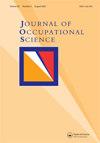Comparing graduate occupational therapy students’ perceived time use, temporality, and tempo of occupational participation before and during the COVID-19 pandemic
IF 2.4
Q1 SOCIAL SCIENCES, INTERDISCIPLINARY
引用次数: 3
Abstract
ABSTRACT The study of time use, habits, routines, and rituals is significant to occupational science inquiry, with established research techniques and numerous published reports documenting the temporal nature of human occupational behavior. Occupational therapy graduate students are therefore instructed on time use analysis methods. In a large public American university graduate program, self-evaluation of time use is used as a learning strategy, providing students rich opportunities to apply what they learn in class to gain a better understanding of their own lives. Following didactic instruction, the students in an introductory theory course were asked to document and reflect upon their time use on a recent day or week in spring 2019. In March 2020, the COVID-19 pandemic prompted a statewide stay-at-home order and widespread school closures, including the conversion of all coursework to alternative online methods. In this context, the students in the following cohort completed the time use documentation and reflection assignment in spring 2020. The data from these assignments provide a unique opportunity to compare time use in the midst of a global pandemic to time use in the prior year. Anonymous data were compared between graduate student cohorts from the spring 2020 semester (n = 59) and spring 2019 (n = 58). Data were compiled and analyzed using NVivo software for qualitative analysis, and SPSS software for quantitative investigation. Results indicate that students attempted to self-organize their time with an emphasis on maintaining or correcting perceived shifts in temporarily and tempo. Students cited concern for their health and reported adjusting patterns of occupational engagement in studying, sleep, rest, and community mobility. Future research should query students’ motivations and feelings related to time use and perception of time.比较职业治疗研究生在COVID-19大流行之前和期间对职业参与的时间使用、时间性和节奏的感知
摘要对时间使用、习惯、日常生活和仪式的研究对职业科学探究具有重要意义,已有研究技术和大量已发表的报告记录了人类职业行为的时间性质。因此,职业治疗研究生接受时间使用分析方法的指导。在美国一所大型公立大学的研究生项目中,对时间使用情况的自我评估被用作一种学习策略,为学生提供了丰富的机会来应用他们在课堂上学到的东西,从而更好地了解自己的生活。在教学指导之后,理论入门课程的学生被要求记录并反思他们在2019年春季最近一天或一周的时间使用情况。2020年3月,新冠肺炎疫情引发了全州范围的居家令和大范围的学校关闭,包括将所有课程改为替代在线方法。在这种情况下,以下队列中的学生在2020年春季完成了时间使用文档和反思作业。这些任务的数据提供了一个独特的机会,可以将全球疫情期间的时间使用与前一年的时间使用进行比较。对2020年春季学期研究生群体之间的匿名数据进行了比较(n = 59)和2019年春季(n = 58)。数据采用NVivo软件进行定性分析,SPSS软件进行定量调查。结果表明,学生们试图自我组织时间,重点是保持或纠正感知到的暂时和节奏的变化。学生们表示担心自己的健康,并报告调整了学习、睡眠、休息和社区流动的职业参与模式。未来的研究应该询问学生与时间使用和时间感知相关的动机和感受。
本文章由计算机程序翻译,如有差异,请以英文原文为准。
求助全文
约1分钟内获得全文
求助全文
来源期刊

Journal of Occupational Science
SOCIAL SCIENCES, INTERDISCIPLINARY-
CiteScore
4.30
自引率
41.70%
发文量
46
 求助内容:
求助内容: 应助结果提醒方式:
应助结果提醒方式:


